©
DAVID CARR-SMITH 2009 : all images and text are copyrighted - please accredit
text quotes - image repro must be negotiated via [email protected]
Key
F11 for full-screen on/off
Click on images to enlarge
DAVID
CARR-SMITH - IMPROVISATION / DESIGN / ART / KITSCH / CHANCE
ART
- GOTHIC into 'RENAISSANCE' into EARLY 20thC
... in process
TRANSITIONS
BETWEEN THREE MODES OF EXPERIENCING
INDEX
AN
ARTIST'S PUBLIC-SITE INSTALLATION WORKS
I
MPROVISED
ARCHITECTURE IN AMSTERDAM INDUSTRIAL SQUATS & COLLECTIVES
IMPROVISED
OPEN-SITE: ("THE NOMADIC COMMUNITY GARDEN")
IMPROVISED
VILLAGES: (WANDSWORTH & KEW BRIDGE 'ECO VILLAGES')
ALLOTMENT
IMPROVISATIONS - PUBLIC, LEGAL, SOCIALLY INDORSED
TEMPORARY-ARCHITECTURE:
("FRANK'S CAFE" & "SOUTHWARK LIDO")
VERNACULAR
- PRAGMATISM & STYLE: (BERDUN VILLAGE BARNS & HOUSES)
"HOME"
- MY LOCATION VIA MASS-PRODUCTS & TASTE - LIV-RM
"HOME"
- MY LOCATION VIA MASS-PRODUCTS & TASTE - HOUSE
"HOME"
- MY LOCATION VIA PERSONAL CHOICES
ART
- GOTHIC INTO RENAISSANCE INTO EARLY 20thC
ART
- 20thC COLLAGE INTO MASS-MEDIA
GRAFFITI
INTO STREET-ART
KITSCH
CHANCE & DESIGN
.
NEW EXPERIENTIAL INFO FORMS
- pt1
... much of this web-page is in process
PART 1: FROM GOTHIC TO RENAISSANCE
PART 2: THE CUSP BETWEEN RENAISSANCE & EARLY 20TH CENTURY
PART 3: EARLY 20thC
... in process
PART 4: PAINTINGS AS ABSOLUTE OBJECTS
... in process
The
following account outlines two radical qualitative changes in European experiencing,
as mediated via art - from Gothic to Renaissance and from Renaissance to the 20th
century.
These two perceptually/experientially transformative enterprises appeared contemporaneously with the relative exhausting of the discovery
potentials of an existent mass-culture. They both consisted of new noticing,
investigating, exposing what, in the hitherto experienced world, had been
relatively unnoticed/ignored.
The
first transition, from Gothic to Renaissance, gave sensational form to an
aspect of the world that was minimised in the preceding Gothic culture, whose highest expression in art was concerned with
forming images of the 'internal' (psychological) experiences
of the 'sacred' and modes of self-existence
that aimed at that fulfillment. The first gropings
towards what would later be recognised as a 'renaissance' are visible in late
Gothic paintings as efforts to assimilate and satisfy the questions: what is
this place/space in which I live/exist and experience thoughts about the sacred,
and: if the sacred is to be experienced
it must surely be also physically actualised - eg: the life of Jesus was performed
in a body in the external-spatial world and its meanings were disseminated
via
external mediation.
This recognition
and affirming of the external world stimulated efforts
by painters to force their attention plus its correlated mark-making to land
not only on the surface of their panel but to 'enter' it, as if exerting
the attention of a touch on an object/place which existed (like their own furniture around them in
their studio) at a distance and position within it.
These attempts to substantiate the outer world in vision and via act opened this new yearning-to-be-discovered region of
experiencing,
that not only revealed to artists a route to completely new sensations but also yielded new perceptions, understandings, feelings of the existential self (hubris
perhaps!), speculations as to the structures of the space we inhabit, the reality of history, philosophies of
ideal existence ... external adventures - the material of a different kind of power.
Initiated by such artists and
artist/mathematicians as Piero della Francesca and Paolo Uccello the Renaissance visual culture
flowered and differentiated until, by the
19th century, it began to reach the boundary of its discovery potentials and split
into two distinct channels - on one hand it regressed into an academic dictation of
functions and methods of art-manufacture, while on the other hand innovative artists
made even more objective and 'immediate' recordings of their sensational//experiential
relations to their external surroundings.
.
PART
1: FROM GOTHIC TO RENAISSANCE - PSYCHIC SPACE TO PHYSICAL SPACE
... in process
The closing of the boundary of the external world
and a substitution of a mental 'ideal-physical' for manifestations of the sacred.
The change from Gothic to Renaissance perceiving was a phenomenon whose earlier
developments were (in the absence of easy transport and communication links) spatially scattered and temporally
unsynchronised. In order to show the inception and
progress of this extraordinary perceptual change I have brought together works that exemplify and illustrate its
stages (some by artists who actively innovated it, others who simply incorporated aspects that came to their attention)
and arranged these in sequences that illustrate aspects of the progress of the
phenomenon, rather than attempting to conserve their chronological relations - especially
since//after all the wave of change eventually subsumed all local regions and converted
all European cultures.
GEN=INTRO_RE GOTHIC ALTERS :
Everything in a picture is visually simultaneous, thus when its task is to
depict transcendent meanings (to reveal the meaning-relation between events separated in
time), it can literally use this characteristic of pictures as meaningful-content,
as the foundation for a presentation of a structure that can depict simultaneously
co-related meanings - the (mental) subject-matter aspect of an altar's main
image. or it may use a row of separate pictures (a predella or
altar-wings) each depicting a revelatory events/acts (typically - in the subsidiary
predella - from an exemplary life lived in the temporal world), all subsumed in and informed by an encompassing eternal/sacred event - the altar's principal overriding image.
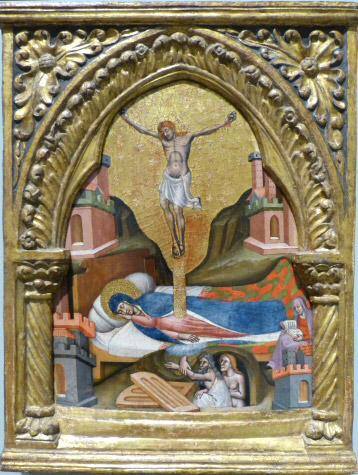
|
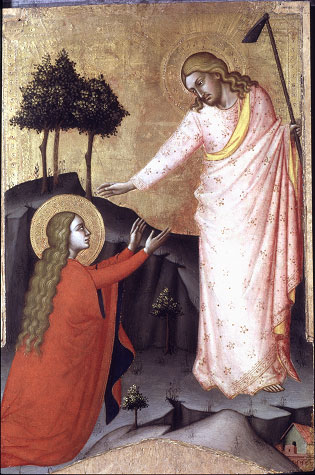
|
|
SIMONE
DEI CROCHEFISSI: DREAM OF THE VIRGIN
about
1365-80 - Bologna - egg tempera on wood - 56.5 x 42.5 cm - NG
London
This work is an example of a type of image and thus experiential structure,
that predates the externalisation of awareness that begins to manifest in
works of the late Gothic [see examples in this
section] and dominates study and depiction in the Renaissance. It
organises references to events that are connected in a web of meaning (which
has been distilled via a study of sources conveyanced as 'traditional belief')
- these are (necessarily) depicted as simultaneous, but
in the external world were separated in space and time.
This practitioner
is not a great artist - for instance unlike Di Cione or Giotto, he is insensitive to the
emotional affectiveness of visual beauty, let alone Giotto's awareness of the
marvel of three-dimensional objects - he almost completely lacks interest in the
sensual aspect of external things.
However he does (almost) succeed in cramming into a visually-related ensemble, a collection of
events which are dislocated in
the external world. Indeed, the picture's event-construction
is surely very like the fossil of a dream!
.
|
JACOPO DI CIONE (Attributed): NOLI ME
TANGERE
about 1370-75 - Florence - egg tempera on wood - 56 x 38.2 cm - pinnacle panel from
a Florence alterpiece - NG London ... in process
|
|
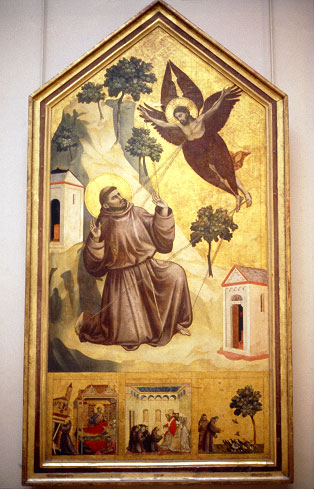
|

|
|
GIOTTO: ST FRANCIS RECEIVES THE STIGMATA
1295~1300 - Florence - tempera on wood - 313 x 163 cm - Louvre Paris
##
... in process
|
BONO
DA FERRARA: ST JEROME IN A LANDSCAPE ... in process
about
1440 - Siena/Ferrara - egg tempera on wood - 52 x 38 cm - NG London
This picture is like a visual book - a
diagram that describes the effort of achieving a sacred//holy life.
It's an instruction plan for aspirants. An 'ad for the church'[1].
The
space within this frame is divided into a mundane foreground world (in which
the saint's body sits and his lion reclines, and an oculus-like opening
into a second
space in which the saint's head, perched upon its white cape, lives and
contemplates (and potentially inhabits). This place beyond the defile between the fringing rocks
is where the sacred is expressed by the almost accessible church and
the implied promise of freedom and release into
the glowing sky. To enter it fully however is still difficult (it still - in
the painting - has the character of a dream or inner-vision) - the saint is
motionless, only contemplatively within its church. Complete entry into the sacred
church is still (in this picture) only potential - he must still pass the
orange rocks (that include his contemplative head and halo within their
outline!), even beyond these, in sight of his goal, is a church-obstructing[?]
wood - the need to overcome its [?]impedance
is signified
by the cut stumps of trees [?]. However,
much has been accomplished in the anteroom of the sacred world: the huge
white rock (continuous in colour with the church - in
substance also? - is it the rock from which the church is built?) is (as
if) jutting from the saint's back - this rock that holds his books,
is cleft by a tree, signifying his effort to grow in spirit in spite of the solidity of the
(foreground) world
VER2-ADD: The edge of the saints white cape forms with the edge of the left-hand cliff an 'eye-like' gap into
this 'other' space//place, which includes at its rear a sky
glowing with the possibility of a golden dawn, a rugged landscape with 3 peaks
(## ?) backing the church (whose door is also glowing
gold). The church is
'reflected' (via similar forms/colours) in the saint's (holy instruction?) books in a
rock niche behind his back - these are (almost) certainly included in the
'sacred' oculus - the doubt signals that they are relevant in both spaces:
the (foreground) world's
tools to help entry to the church (etc) which chimes their forms - a white note
hanging below them [WHAT DOES THIS SAY ??] (almost)
continues the cape's lower edge, (almost) completing the 'sacred oculus' to
the right frame and including these books within it.
NOTE:
[1] NB: an analogue: B&H Xmas-card
advert !]:
|
|
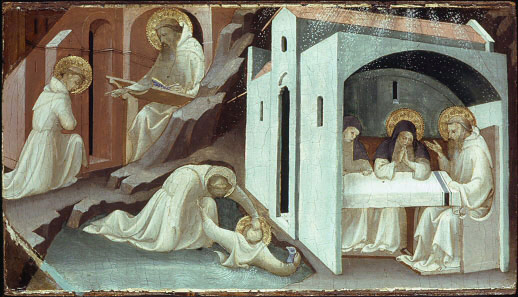
|
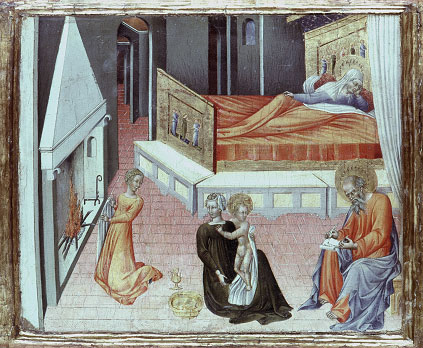
|
|
LORENZO MONACO: INCIDENTS IN THE LIFE OF ST
BENEDICT (LEFT PANEL)
1407~09 - Florence - egg tempera on wood - 28.4 x 52 cm - predella (left panel) -
NG London
Throughout this predella - illustrating
significant events in the saint's life - Lorenzo demonstrates and undertakes
to extend his ability to visualise and render what seems to him (and his
culture) the most essential of his painting's subject-objects: the figures
(while leaving their architectural containers merely formulaic). His interest in
and visual grasp of groups of figures as single complex solids (their shapes simplified however by robes and determinedly
monochromatic) is both sensationally and conceptually powerful.
Though consisting of only two figures, it appears that the most difficult of these groups to
visually conceptualise as a single
three-dimensional solid-form was the baptism - further
complicated by extending the form of the saint's arm and hand into a small blue jug.
|
GIOVANNI
DI PAOLO: THE BIRTH OF ST JOHN THE BAPTIST
1454 - Siena - egg tempera on wood - 30.5 x 36 cm - predella (left panel) - NG
London
The emerging desire to make a painting image the external world is here
exemplified in just one small case of struggle with the difficulty of exerting
control of ones perception and its correlated mark-making. The fire in the
grate is the inconspicuous opportunity: an object in the painting of no
liturgical meaning-importance and thus open to different modes//means of
representation - for instance, it is untrammelled by the tradition of figure depiction, a
mode of representation already highly developed because of its central
importance in the iconography of religious painting. Indeed, as this case demonstrates,
although Giovanni is already quite able to convincingly portray the 3-dimensional
complexity of clothed figures, these display
nothing of the tension of initiating a completely new and real perception, their competent depiction is
nothing like the effort to
perceive reality, to use paint to
sense the
objective
solid indupitable present factuality of the object that is the
fire: its ash, sticks and flame.
Because the artist - in respect of
this tiny portion of his oeuvre -
for some indeterminable reason - was driven to
try to do something which had no skilled precedent, for which there existed
no established depictive form; driven to exert a determination to actually perceive
rather than beautifully paint from inside the canons and skills of his learned
craft - he
experienced what, since the late 19th C, has been considered the most
extraordinary function of art: its application as a means of personal
experiencing, its use as a direct means of pushing beyond
established boundaries of recognition and knowing into a region of eliciting
direct experiences. One sees analogous experiential innovating in the much
grander works that initiated the Renaissance: Piero, Masaccio, etal - but
does one ever see such a struggle to real-ise spent on a subject-matter of such inconsequentness
before the late 19thC !
The consequence of this tiny portion of depictive painting
being, as it was made and during the struggle of its making (it's not
even fully solved!: note the wood that won't lie-down!),
an unprecedented experience of present-moment
realising - is that we also see it (after 561
years) still as present experience - we read his actions being made in
present moments that we experience as our own. Personal discoveries
rendered via work, are always experienced, not only by their maker but also
by their spectator, as timeless, or rather as a present in time that is
present throughout time, bound not by the date of its origination but only
by the attuned attention of a human perceiver. This is the
junction of discovery via both Art and Science.
.
|
|
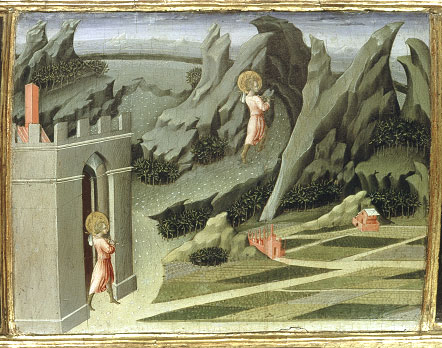
|
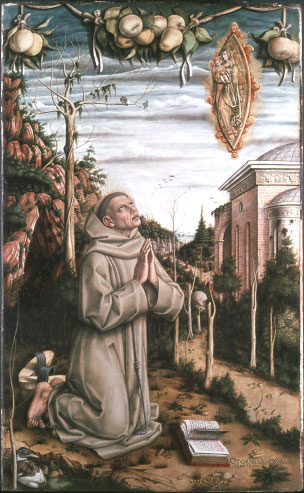
|
|
GIOVANNI
DI PAOLO: ST JOHN THE BAPTIST RETIRING TO THE DESERT
1454 - Siena - egg tempera on wood - 30.5 x 49 cm - predella panel - NG London ... in process
|
CARLO CRIVELLI: THE VISION OF THE BLESSED GABRIELE
about 1489 - Venice - egg & oil on wood - 141 x 87 cm - NG London
... in process
|
|
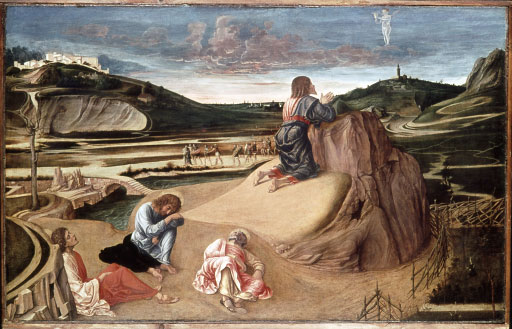
|
perspective painting
|
|
GIOVANNI BELLINI: THE AGONY IN THE GARDEN
about 1465 - Venice - egg on wood - 81.3 x 127 cm - NG London
... in process
|
|
|
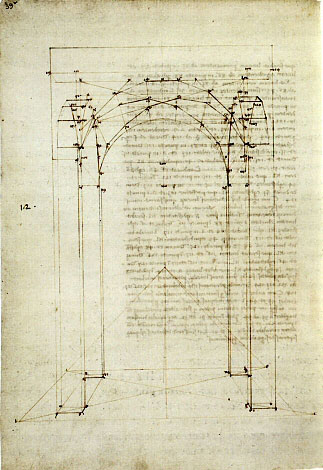
|
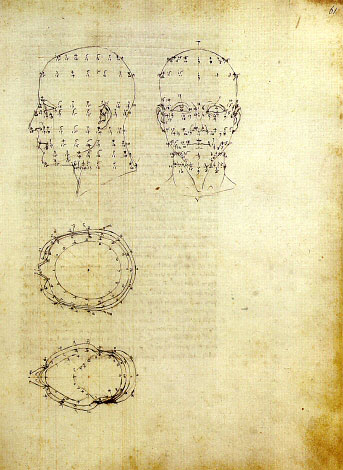
|
|
PIERO
DELLA FRANCESCA: PERSPECTIVE DIAGRAM: AN ARCHED VAULT SUPPORTED BY FOUR
PILLARS
around 1480 - page from De Prospectiva Pingendi
(Perspective for Painting) - Biblioteca Ambrosiana, Milan. ...
in process
Every increase in human awareness is noticed, investigated, expanded and
differentiated (in this example via a treatise by an innovating
mathematician/artist).
This abstracting/simplifying and precisionising of the shape-structure(s)
of the external-visual world (the direction from which most body-affecting
events emerge) leveraged means of pragmatic power (eg: visualising
territory) and - as its results, rules and methods filtered into
the culture of the late 15thC - enabled
even minor,
non-innovating, 'craft-artists' to drag their fantasies//mental-visions
into an externalised depiction which (in an increasingly extraverted
culture) made them persuasively real.
|
PIERO DELLA FRANCESCA: HEAD ANNOTATED FOR PERSPECTIVE PROJECTION (?)
( DIAGRAM)
before 1482 - page from De Prospectiva Pingendi
(Perspective for Painting) - Biblioteca Ambrosiana, Milan.
... in process
|
|
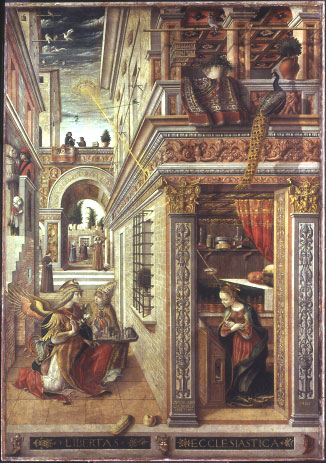
|
|
|
CARLO CRIVELLI: THE ANNUNCIATION, WITH SAINT
EMIDIUS
1486 - Venice - egg & oil on canvas - 207 x 146.7 cm - NG London ... in process
|
RAPHAEL
|
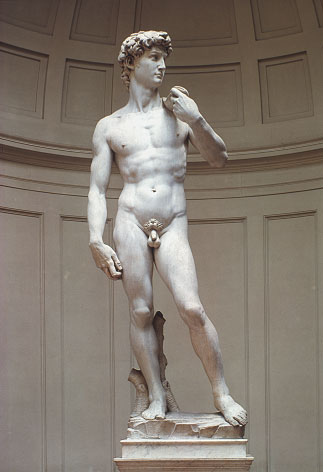
|
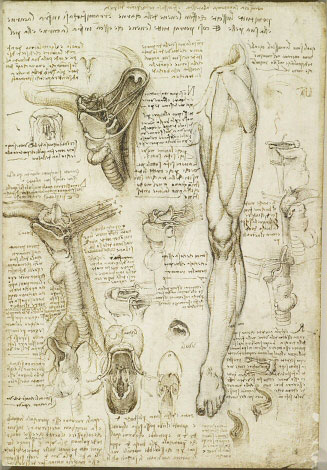
|
|
MICHANGELO: DAVID
1501~04 - Florence - marble - 5.17m -
Galleria dell' Accademia, Florence
... in process
|
LEONARDO
DA VINCI: THROAT & MUSCLES OF LEG (ANATOMY RECORDING)
c1510-11 - note-book page - pen & ink + wash over black chalk - 29 x 19.6 cm - Royal
Collection Trust, Windsor.
... in process
|
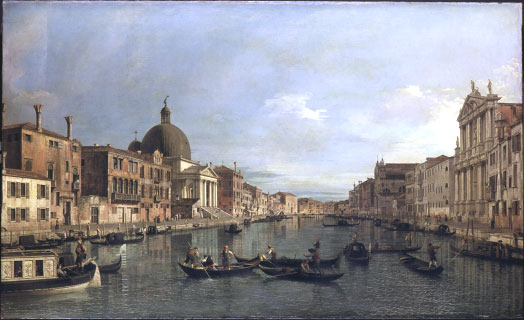
|
|
|
CANALETTO:
THE GRAND CANAL WITH S SIMEONE PICCOLO
about 1740 - Venice - oil on canvas - 124.5 x 204.6 cm - NG London ... in process
In some portion of our
sense this is the almost perfect rendering of a perceived external place, in
another (educated via the 'attention' research of the late 19C (so-called)
Impressionism) it seems, though fascinating, as unreal as a model,
completely lacking the scale of the actuality in which we exist and are. The
dominance of an over-encompassing method of seeing; the
completion/perfection of a technique of rendering the appearance of spatial
location (called 'perspective'), has finally become a (belief-)system that
filters and separates vision from experience, as if a straight-jacket around
the exercise and means of perceiving. Such paintings are beautiful and
fascinating recordings of a perfected aspect of culture (thus almost defunct
in its ability to open the world), which nevertheless, as a whole, still has
two centuries worth of other resources to exploit and extend - more inward,
ideal, romantic, visionary, fantastic, and degenerate - before artists
return to sensationally oriented experiencing per se.
|
baroque
|
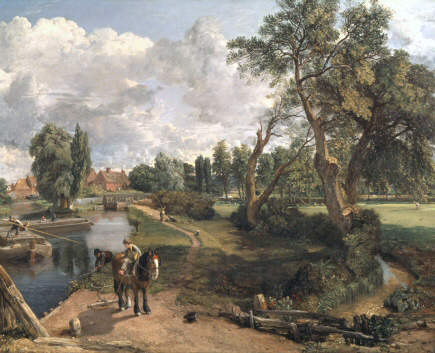
|
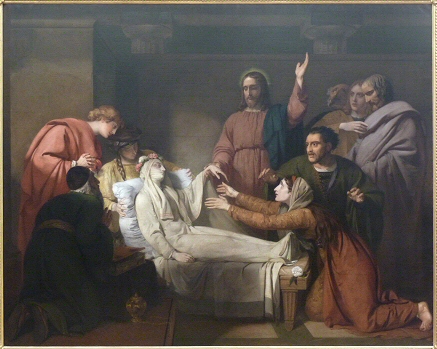
|
|
CONSTABLE:
FLATFORD MILL ('SCENE ON A NAVIGABLE RIVER')
1816-7
- oil on canvas - 101.6 x 133 cm - Tate Britain
... in process
Constable is entering
the external world with an attitude of subservience to its perceived
reality that has never before been expressed at this level of apprehension
of the complexity of its detail, the variety of its objects, and their
astonishing cooption (within an arbitrarily chosen rectangle) in a
visually ordered holistic 'view' that even elicits from ones (peculiar)
brain a feedback-response of 'beauty'!
|
HENRY THOMPSON: THE RAISING OF JAIRUS'
DAUGHTER exhibited
RA 1820 - British - oil on canvas - 241.4 x 299 cm - Tate Britain ... in process
This huge piece of (in
its mental-subject/visual-formulation/physical-technique)//(in all its
obvious aspects) derivative nonsense,
is hanging (03-2018) next to
Constable's Flatford Mill (previous
picture) which pre-dates
this painting's exhibition date by at least three
years! The little Constable, in the context of this contrast, can be
used to represent the next obvious
redirection of consciousness since the last huge
paradigm shift from Gothic
to Renaissance.
|
.
PART
2: THE CUSP BETWEEN RENAISSANCE & THE 20TH CENTURY - RE-APPREHENSION OF VISUAL & SOLIDITY SENSATIONS
... in process
The
debasement of Renaissance experiential culture and its final 're-renaissance'
in the late 19th century, are precursors of a new experiential paradigm that
opened in the early 20th century.
The experiential potentials of means of perception, mediated via Renaissance painting, were
almost exhausted by the 19th century. Painting's
experiential exploration had devolved into methods of picture-manufacture, and
its means of depiction were separated from its subject-matter. This
morgification
of painting (institutionalised in the
19th and early 20thC art academies) initiated an exploitation by artists of its
last uncorrupted experiential aspect: immediate sensations untrammeled
by
'socially significant' subject-matter.
Thus the last experiential endeavor of the
'Renaissance' was an investment in as direct as possible sight and apprehension
of external physical solidity; it was as if, at the moment of almost complete
exhaustion of its potential for discovery, that that culture was returned to its
origins: its investigation and experiential substantiation of the visual
structure of the external world, but this time stripped of arbitrary subject-matter. The externally sourced sensations themselves were finally - after
4
centuries of applying the potential of 'external-spatial-depiction' for proving//substantiating//actualising
(in the apprehension of the viewers of that time)
the external reality of socially
valued and sacred objects and persons - allowed to be
in themselves the objective 'subject-matter'. The external world was de-populated of
mentally-crafted and sacred ('from beyond its limits') objects and the world
was itself identified as sensation. With the now falsely located subject-matters expunged, the way was cleared for a new
physical><mental experiential reality-structure whose sensational forms were initiated via early 20th century artworks by Picasso, Ernst,
et al. ... in process
Though
sensations of visibility and solidity are separate modes of apprehending the
'external world', we automatically - via an 'internal' mental faculty -
construct our apprehension of space and objects from visual cues (perspective
scale etc), so that in effect we can 'touch at a distance'. This 'physical'
apprehension of distance, position, solidity (without body contact) can be
enhanced//focussed in ones//via attention. Certain artists of this 'cusp' period (spanning the end
of the 19th and start of the 20th centuries), which corresponded to the exhaustion/degeneration of the discovery-potentials of the
'Renaissance', (an exhaustion expressed in the degenerate codified
art-production typical of the art academies : the Ecole des Beaux Art, etc), in
effect 'cleansed the Augean stables' by returning attention and
working motivation to as direct-as-possible sensation. Both Manet and
later
Monet submerged themselves in the activity of externalising their vision - Manet grasping
at the immediately perceived preseent structure of encountered scenes, Monet
treating the picture as a sort of projection screen on which to accumulate his visual
sensations as immediately as possible. At the other end of
the sensation continuum, Cézanne attempted to directly perceive the solidity of
external things and space, working on finding forms whose visual relating forces
the brain to perceive, in spite of the physical flatness of the picture, spatial solidity and
positional depth. One by one the by then encoded
aspects of Renaissance art were rejected to allow the purity of the pure
'science' of sight to invest their whole work.
... in process
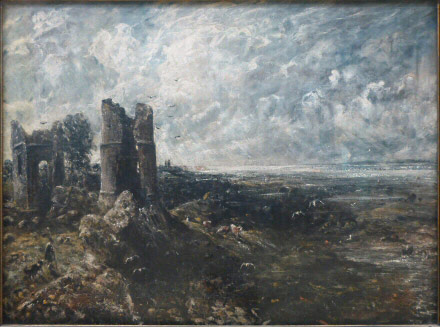
|
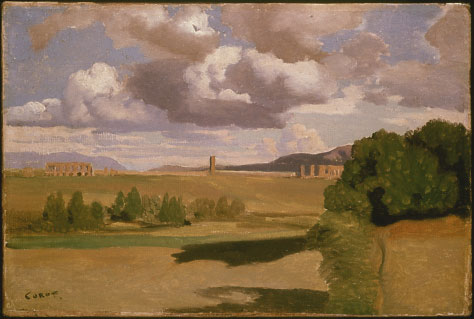
|
|
CONSTABLE: HADLEIGH CASTLE
c1828-9
- oil on canvas - 122.6 x 167.3cm - Tate Britain, London
This powerfully magnificent sensation-saturated image is,
at its most superficial end, just
that - an image. The actual scene, however sensationally presented, and of
course sensed thus by the artist, is distilled and filtered into a picture, one whose conviction partly rests in a tradition of evoking
emotional effects by the arrangement of confrontations (eg: the empty tower
and the distant space of sea / the small man facing a summation of his vast
location in the towering clouds). A romantic drama - the 'reality' of whose
effects are endorsed
and balanced by
the actuality of the physical sensations that affirm their
forms - sensations culled via many hours spent directly transposing external
visual events into corresponding forms and marks of paint.
How
different and cleared of any bludgeoning
traditions is the Corot, which simply reports a 'chance' portion of the visual
field whose 'meaning' consists only in the automatic catching of the eye's
attention by the (almost) central tower.
.
|
COROT: THE ROMAN CAMPAGNA, WITH THE CLAUDIAN
AQUEDUCT
prob 1826 - oil on paper on canvas - 22.8 x
34 cm - NG London
A landscape in direct sight - not a 'model' or perspectively informed
construct - just a simple report of his direct sensations of standing in
this view. His attention is focussed on the mid-distant tower, near his
position the ground is perceived but not considered, not in focussed
attention.
|
|

|
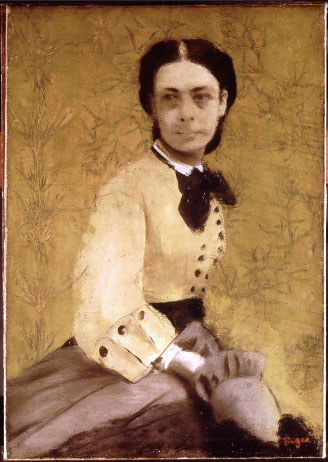
|
|
TURNER: ROUGH SEA c1840-5
/ 91.4 x 121.9cm / oil on canvas / Tate Britain, London
Probably an 'unfinished' picture or (like Constable's) a full-sized
'sketch'. However this could be catagorised as the 'hidden' stage of the
emergence of a type of art-mediated experience that would only openly
manifest in the 20th C.
The painter apparently seeks to
merge in his present awareness the sensational phenomenon and his acts of
painting it. The eschewing of a traditional morally/socially significant
subject matter (which he almost always, at least smuggles into his
'finished' paintings); his total immersion in the significance of any
immediately realised experience (and the consequent rejection of all
academic credos) heralds the future functionality of art.
|
DEGAS: PRINCESS PAULINE DE METTERNICH
about 1865 - oil on canvas - 41 x 29 cm - NG London
A present instant captured - originally by a camera. Now the character
of this momentary image and its subject-origin
is deliberately introduced into portrait
painting, a medium that
historically attempts to endorse most solidly the presence and the substance
of the sitter now reports the substance of a momentary glance.
|
|
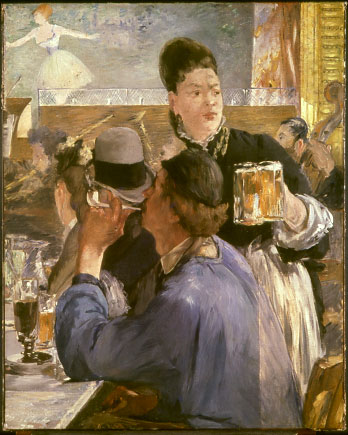
|
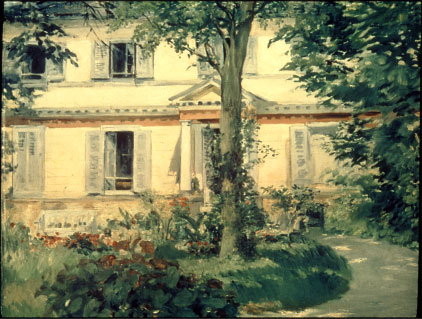
|
|
MANET: CORNER OF A CAFÉ-CONCERT
prob
1878-80 - oil on canvas - 97.1 x 77.5 cm (this started as half of a larger picture of 1878,
and was then enlarged to the right) - NG London ... in process
Attention (and its attendant
focus) flickers around - mainly in the foreground of this visualised place.
This extraordinary picture takes as its 'subject' the ordinary random
wandering of our distracted awareness, it has no pretensions to conveying
any visually-distilled/unified 'useable meaning'. It's perhaps ironic that in its
background and almost completely unregarded, is a presentation of a
traditional theatrical spectacle.
.
|
MANET: THE HOUSE AT REUIL
1882 / oil / 92.3 x 71.5 cm / Alte Nationalgalerie, Staatliche Museen,
Berlin
After the visually constructed subjects of the Renaissance and
of academic paintings of the 19C, this astonishingly realistic image looks as transient, uncomposed and inconsequential as real (in between intention and goal) experiencing.
Its main content is an event that we had been taught - by
preceding centuries of art endeavor - to consider utterly without significant
meaning, to have no mental substance commensurate with visual monumentalising (painting was generally used and admired as an art of results not of investigations). It depicts a moment of visual attention cut like a film frame from our approach to a house ... while passing peripherally noticed herbage beside the driveway one focuses on ones goal, its doorway, momentarily hidden behind an undefinitely noticed tree.
Its affect goes beyond visual reporting because its structure is such a precise report of such a typical cross-sectional moment in the midst of executing an intended act. As one walks towards ones goal (the entry of the house) ones sense of intention is momentarily muddled by a (visually-obtrusive yet irrelevant) foreground thing. As the picture-viewer I experienced this jolt to my certainty//intention as a moment so realistically corporeal as to engage a complex of senses and (even) physical responses in the immediate perception ... this painting is not only a report about the external world but an invoker, indeed an
actualiser of experiences of being and acting in it.
This picture confirms that what is meaningful
was entering a new phase - the externally envisioned is being superceded by sensory experience that includes the viewer's being-participation
Compared
with this sensational adventure the Corot [see above] is a very simple visual
moment.
.
|
|
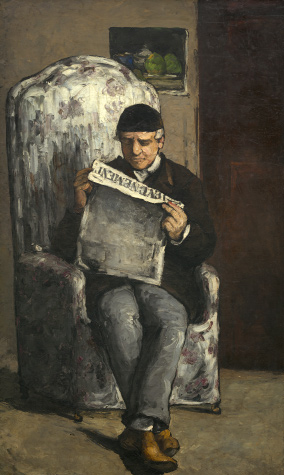
|
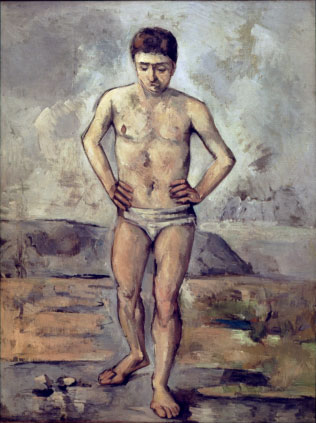
|
|
CÉZANNE: THE
ARTIST'S FATHER, READING "L' ÉVÉNEMENT"
1866
- oil on canvas - 198.5 x 119.3 cm - NG
WASHINGTON ... in process
|
CÉZANNE: THE BATHER
1885
- oil on canvas - 127 x 96.8 cm - MOMA,
NEW YORK ... in process
This
extraordinary (almost completely successful) effort to make tactilely and visibly
tangible the presence of a solid object
in/and its corresponding space, more completely than any
previous historical picture (including,
or rather especially, the most perfect tromp l'oeil).
To
do so in a way that bends the flat surface in the attentive perception of the
viewer (without resorting to illusory means such as perspective)
.
|
|
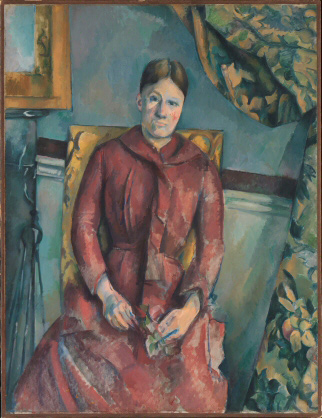
|
ADD CEZANNE 'SOLID' LANDSCAPE
(Tate-M-exh~2023)
|
|
CÉZANNE:
MADAME
CÉZANNE IN A RED DRESS
1888~90
- oil on canvas - 116.5 x 89.5 cm - MET, NEW YORK ... in process
#
.
|
.
|
|
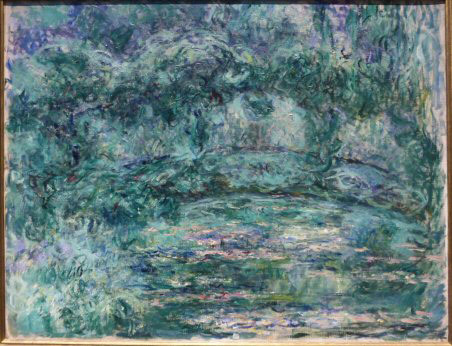
|
|
|
MONET:
THE JAPANESE BRIDGE
around 1919~24 - oil on canvas - ## x ## cm - NG London (loan) ... in process
The whole painting-surface plus external-subject has become a perception of
a single massive form.
.
|
|
.
PART
3: THE EARLY 20thC - SIMULTANEITY OF PHYSICAL AND MENTAL SPACES
... in process
The Cézanne is hardly different from a Bellini et al when both are
compared to a 1912 Picasso. What
is this extraordinary change? It's a way of perceiving, not just seeing, it
includes ones mind - it requires active participation in the artist's
perceptions as embodied in the art-work, it is no longer enough to be a ravished
spectator of a presentation.
Just
as Piero della Francesca et al (apparently for the first time) distilled from
observation the general properties of the
'external' visual world, ratified these via
math//calculation and tested their application to specific objects,
rendered on drawings and paintings as if projected on the plane of the eye [ref
head-drawings above], so Picasso and Braque between 1909 and 1914 worked on a radical reformation of the structure of our directly
experienced world, that attempted a less illusory
depiction of its space and solidity - reaching out, as Cézanne does, to touch and relate together all locations within the picture, but
(without losing
Cézanne's sense of direct contact with spatial physicality) dispensing (more
than he found possible) with other aspects of external appearance,
sacrificing subject-matter-recognisibility to a single-minded effort to
force the pictured forms to evoke, via the
perceived relating of their parts, a perceptual experience of immediately
actualised spatial solidity, which included the picture as an area-limited 2D
surface, whose actual
existence was the support for and visual starting point for every depicted
form all the artists mental excursions into // which
every mark of paint defined and which thus was forced to endorse the (at least) mental actuality of the
depicted space.
-----------
Just
as Piero della Francesca et al, apparently for the first time, worked out the general properties of the
'external' visual world, and tested their application to specific painted objects [ref
his head-drawings above], so Picasso and Braque between 1909 and 1914 worked on
the initial phase of a
radical reformation of the structure of our directly experienced world, via
paintings that attempted a more complete
way of depicting the space and solidity of
the visual/physical things that surround us
- reaching out, as Cézanne does, to touch and relate together all locations within the picture,
but (without losing Cézanne's sensations of direct contact with spatial
physicality) dispensing (more than he found possible) with other aspects
of external appearance, initially
sacrificing
subject-matter-recognisibility to a single-minded effort to force the pictured//painted
forms to evoke,
via the relating of their parts, a perceptual
experience of
actualised spatial solidity, whose
(at least) mental actuality was
endorsed by
the fact that every mark of paint
visibly touched//defined
the painting's
physically flat and area-limited
surface
(a superficial aspect of these
work's appearance was stupidly and misleadingly named "Cubist")..
-------------------
..that, while every form
can be read as directly on the surface, when seen in
relation to another it takes a relative
position inside the picture space
the incorporation of the physical flatness of the picture [NB: remark re
Cezanne~end of Intro to previous section] as an aspect of meaning and
subsequently the whole painting as a thing among all other things.
Just
as those painters at the inception of the Renaissance attempt to physically/tactilely reach
into the depicted space in their pictures - a space that became (when its shape had
become fully defined and thus reduced in direct physical
experience !) codified as 'perspective' depth - so these early 20th century
artists sought to form a simultaneous presence of the external physical and the
internal mental by including the last ((hitherto ignored) aspect of their
'images', their physical existence//reality//actuality//presence
relative to the picture's physical
surface [[[?]]].
|
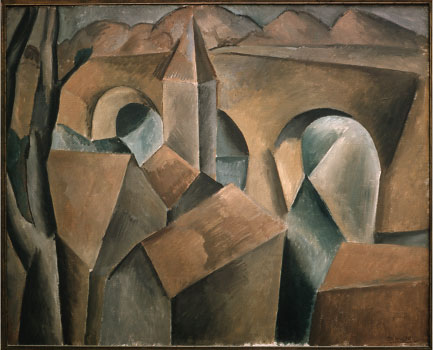
|
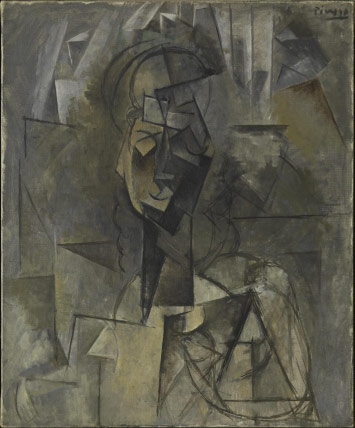
|
|
PICASSO: LANDSCAPE WITH BRIDGE
spring 1909 - oil on canvas - 81 x 100 cm - Veletrní Palác, National Gallery,
Prague
An extraordinarily complex mass of multi-related forms which however demands
to be seen all at once as a single object. This picture (still - even after
104 years) sets up in ones attention an acute condition of active demand to
encompass all its spatial relations simultaneously.
The act and problem of taking a spatially real landscape and - without
compromising with (by the late 19C)
non-experiential painting techniques of traditional
visual illusionism - compressing it into the form of a
painting that is directly sensational, is a
motivation of this extraordinary development in art
|
PICASSO: WOMAN - HEAD AND SHOULDERS
1909-1910 - oil on canvas - 73 x 60 cm - Pompidou Centre, Paris
... in process
|
|
|
|
|
Georges Braque, 1908, Maisons et arbre, oil on canvas, 40.5 x 32.5 cm, Lille Métropole Museum of Modern Art
|
|
|
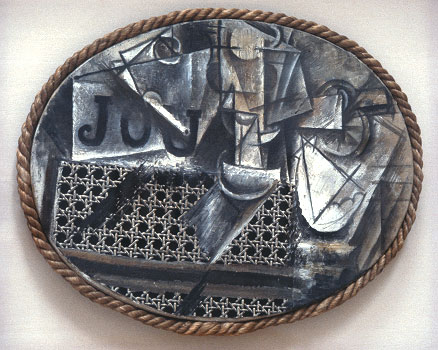
|
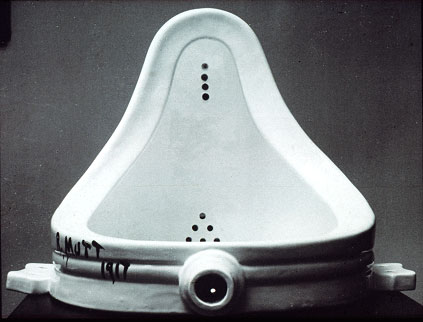
|
|
PICASSO:
'TABLAU-OBJET' - STILL-LIFE WITH CHAIR-CANING
1912 - (MUSEÉ PICASSO)
The structure and functioning of this generative object of the new
experiential paradigm is discussed below :
The
object's 'reality aspects' are manifold:
The painted still-life / the printed chair-caned oil-cloth / the rope fixed to the stretcher edge 'outside the picture'. Each 'layer' relegates the layer 'below' it to 'mentality' and the layer 'above' it to 'physicality':
- The tactile paint marks confer reality on the visual space and mental signs.
- The printed oil cloth, as real object from outside, proves the paint-space is illusion, but has its realistic chair-caning confirmed as mental sign.
- The rope, forced between image and outside, fixed to the physical picture, banishes the tromp l'oil chair-caned oil cloth, both its illusion and its substance, to the relative mental plane of the image.
Because there are 3 layers the shock of realising that 'real' is identity of mental and physical is confirmed!
NB:
In the art of the previous cultural period (Renaissance to late 19thC) this relation of illusion and object is
(only) potential - vis:
- Tromp l'oeil, whose illusions are marvellous in so far as they 'tromp' their physical support.
- The duality of subject and paint was fully developed in
the late 19thC: Courbet, Monet, Cézanne. However not even they achieved the dual-unity of subject and
the physical 'painting'.
|
MARCEL DUCHAMP: "FOUNTAIN" - CERAMIC URINAL WITH 'SIGNATURE'
& DATE
1917 ... in process
'Collaged'
into an open art exhibition, the resulting experiential form includes: urinal in an art show ! - the clash of "R. MUTT" and 'signature'
- the complex exchanges between urinal and "Fountain"
(sculpture, drinking) exacerbated by the position of the object - the
transformed exhibition event, the submission procedures, the sudden
visibility of the question "what is art" (certainly not an
exhibit in this exhibition !).
It's a shockingly 'naked' intrusion into the by-then comfortable zone of collage -
its 'found-object' is collaged onto the tableau of the 'outside' world! It's an 'objet' that is associatively about as opposite from its contemporary Art as is possible - it breaks (the
'mould of') synthetic cubism completely open again (more open than the first 1912 papier-colle must have been). It brings art (at least for art's spectators) to a standstill, it
makes a
('disgustingly') familiar object unique,
but//yet also superficially seemed to baptise any
existing object's potentiality as art, however this was to ignore the fact that
this particular object originated as a choice - which inevitably brought it
into the world of meanings; that it was titled "Fountain", which with
its spatial re-orientation and consequent evoked an associational context
(for me) of ;
'signed' "R. Mutt 1917"; re-positioned; inserted into a
particular alien context.
.-----------------
It's a shockingly
naked intrusion into the by-then comfortable zone of collage - its an
'objet-trouvé' that is collaged onto the tableau of the utterly
familiar meanings of the social world! It's an 'objet' that is associatively about as opposite from its contemporary Art as is possible -
it solves the 'modern-art' subject-matter problem - vis the
historically familiar subjects that support even the radical
reality-reformulations of synthetic cubism, it breaks s-c's confining
historical mould, its artistically 'normal' subject-matter. It brings into a
public position of uniqueness an object that has conceptually
an almost hidden//negated existence - a common thing and associated
act that has almost no social expression//meaning it
forces than the first 1912 papier-colle must have been). It brings art (at least for art's spectators) to a standstill, it makes a
('disgustingly') familiar object unique,
but//yet also superficially seemed to baptise any
existing object's potentiality as art, however this assertion ignores the fact
that
this particular object originated as a choice which inevitably brought it
into the world of meanings; that it was titled "Fountain" which
with its physical re-orientation and consequently evoked (for me)
an associational context of 'ornamental water-control'; that it was 'signed' "R. Mutt 1917",
which mocked its originality and confirmed its vulgarity;
inserted into the particular alien context of
useless but uplifting art. The choice of this ultimately
humble object as an art object (: its insertion
into an art exh) - consequent suggestion - on
one hand - that Any object could posture as an art-object - that thus
art-objects had no value - its especially low (if not "disgusting")
social meaning//status/responses, that its new context however
flatulated//focussed so that its socially nurtured//## meanings became its
(only) subject-matter (as it were in parallel with this Chosen-as-Unique
object). Thus the completely newly modern Modern-Art of Conceptualism
was born.
|
|

|
|
|
MAX
ERNST: "2
CHILDREN THREATENED BY A NIGHTINGALE"
1924 - COLLAGE & OIL-PAINT ON
WOOD - 18 x 13in - (MOMA, NY)
... in
process
|
|
|
|
|
|
|
|
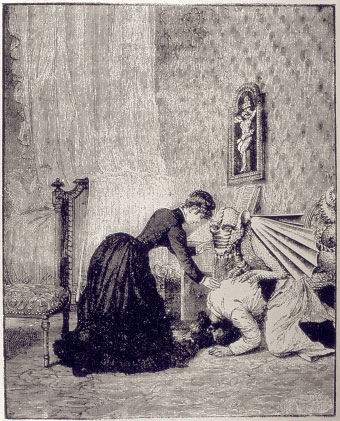
|

|
|
MAX ERNST: "UNE SEMAINE DE BONTÉ" - BOOK-3 / #17
1934 - Paris
[reserve
... in process
|
MAX ERNST: "UBU ENCHAINÉ" THEATRE
SET
1937 - Production: Sylvain Itkine - Paris
[reserve
... in process
|
|
|
|
|
|
|
|
|
|
|
|
|
|
|
|
|
|
|
|
|
|
|
|
|
|
|
|
|
|
|
.
PART 4
: PAINTINGS AS 'ABSOLUTE OBJECTS' &
ABSOLUTE OBJECTS AS ART ... possible?
The
reduction of all the marvellous complexity of sensational awareness mediated
through the practice and consumption of art,

|
|
|
ILYA
KABAKOV:
1965
- BOARD-BOX, REPRO OF A RUISDAEL PAINTING & PAPIER-MÂCHÉ ARM
|
|
|
|
|
|
rothko
|
|
|
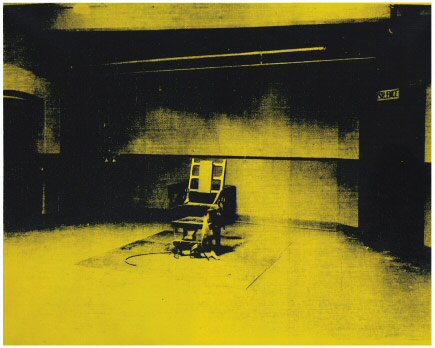
|
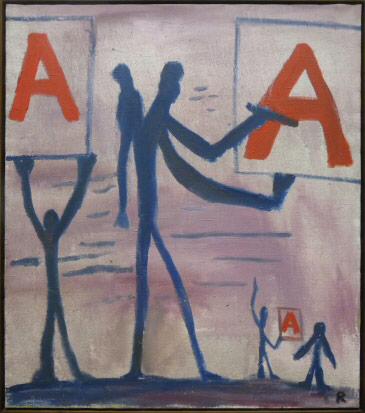
|
|
ANDY WARHOL: (electric-chair)
|
A.
R. PENCK: UNTITLED (SYSTEM PAINTING)
1966 - oil on canvas - 109.5 x 95 cm - Michael Werner Gallery
... in process
|
^ Top
> Next
Section >
INDEX
AN
ARTIST'S PUBLIC-SITE INSTALLATION WORKS
I
MPROVISED
ARCHITECTURE IN AMSTERDAM INDUSTRIAL SQUATS & COLLECTIVES
IMPROVISED
OPEN-SITE: ("THE NOMADIC COMMUNITY GARDEN")
IMPROVISED
VILLAGES: (WANDSWORTH & KEW BRIDGE 'ECO VILLAGES')
ALLOTMENT
IMPROVISATIONS - PUBLIC, LEGAL, SOCIALLY INDORSED
TEMPORARY-ARCHITECTURE:
("FRANK'S CAFE" & "SOUTHWARK LIDO")
VERNACULAR
- PRAGMATISM & STYLE: (BERDUN VILLAGE BARNS & HOUSES)
"HOME"
- MY LOCATION VIA MASS-PRODUCTS & TASTE - LIV-RM
"HOME"
- MY LOCATION VIA MASS-PRODUCTS & TASTE - HOUSE
"HOME"
- MY LOCATION VIA PERSONAL CHOICES
ART
- GOTHIC INTO RENAISSANCE INTO EARLY 20thC
ART
- 20thC COLLAGE INTO MASS-MEDIA
GRAFFITI
INTO STREET-ART
KITSCH
CHANCE & DESIGN




































